Waseda University
| Waseda University | |
|---|---|
| 早稲田大学 | |
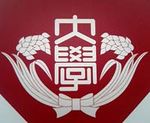 |
|
| Motto | 学問の独立 (Independence of Learning) |
| Established | 1882 |
| Type | Private |
| Endowment | N/A |
| President | Katsuhiko Shirai |
| Academic staff | 2,038 full-time 3,847 part-time |
| Admin. staff | N/A |
| Undergraduates | 45,757 |
| Postgraduates | 8,471 |
| Location | Shinjuku, Tokyo, Japan |
| Campus | Urban |
| Athletics | 43 varsity teams |
| Colors | Maroon [1] |
| Mascot |
Waseda Bear (official)  |
| Affiliations | Universitas 21, APRU |
| Website | Waseda University |
Waseda University (早稲田大学 Waseda Daigaku), abbreviated as Sōdai (早大 Sōdai), is one of the most prestigious private universities in Japan. Its main campuses are located in the northern part of Shinjuku in Tokyo. Founded in 1882 as Tokyo Senmon Gakko, the institution was renamed "Waseda University" in 1902. It is known for its liberal climate symbolized by the motto "independence of learning" (学問の独立 gakumon-no-dokuritsu).
The alumni include six post-war prime ministers and prominent corporate leaders. Currently, seven of the Fortune Global 2007's CEOs are Waseda graduates. [2].
Waseda University is a member of Universitas 21, an international network of 21 universities that have a particular focus on research.
Contents |
Institution

History and development
The university was founded by samurai scholar and Meiji-era politician and former prime minister Ōkuma Shigenobu in 1882, and was designated as a full university in 1902. It started as a college with three departments under the old Japanese system of higher education.
In 1882, the university had the department of political science and economics, law, and physical science. Along with these departments, an English language course was established, where the students of all the departments could learn English.[1]
Three years later, the department of physical science was closed because it had too few applicants.[2] The department of science and engineering was established in 1908.[3]
The department of literature was established in 1890.[4]
The department of education was established in 1903, and the department of commerce, in 1904.[5]
Much of the campus was destroyed in the fire bombings of Tokyo during World War II, but the university was rebuilt and reopened by 1949. It has grown to become a comprehensive university with two senior high schools and school of art and architecture.
Origin of the name
Waseda University started its life as Tokyo Senmon Gakkō (東京専門学校) on October 21, 1882. Before the name 'Waseda' was selected, it was known variously as Waseda Gakkō (早稲田学校) or Totsuka Gakkō (戸塚学校) after the location of the founder's villa in Waseda Village and the school's location in Totsuka Village respectively.
It was renamed Waseda University (早稲田大学 Waseda-daigaku) on September 2, 1902 upon acquiring University status.
Academic cap

Ōkuma had long desired to create an academic cap so distinctive that someone wearing the cap would immediately be identified as a Waseda student. The chief tailor of Takashimaya, Yashichiro, was called upon to design a cap in three days. Each square cap was stamped on the inside with the student's name, his department, the school seal and the legend, "This certifies that the owner is a student of Waseda". Thus, the cap served as a form of identification, and effectively a status symbol. The cap, with its gold-braided badge, is registered as a trademark.
125th Anniversary
On October 21, 2007, Waseda University celebrated its 125th anniversary. Ōkuma often talked about the "125 years of life" theory: "The lifespan of a human being can be as long as 125 years. He will be able to live out his natural lifespan as long as he takes proper care of his health", because "physiologists say that every animal has the ability to live five times as long as its growth period. Since a man is said to require about 25 years to become fully mature, it follows that he can live up to 125 years of age." This theory propounded by Ōkuma was very popular and often referred to in the media of the time.
In commemorative events relating to Waseda University and Ōkuma, the number 125 is accorded special significance, as it marks an important epoch. The tower of Ōkuma Auditorium, completed on the university's 45th anniversary, is 125 shaku, or about 38 m high. In 1963, there were also events to mark the 125th anniversary of Ōkuma's birth.
Ōkuma, who twice served as prime minister of Japan, organized his second cabinet when he was 77 and died when he was 83. He said, "I wish I had understood this '125 years of life' theory 30 years earlier". He did, however, lead a regular life, and lived fairly long compared to other Japanese at the time.
Campuses
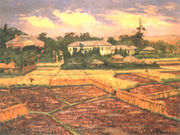
Waseda University's main campus is located in the Nishi-Waseda district of Shinjuku. The nearest station is Waseda, although Waseda is generally associated with Takadanobaba on the Yamanote Line.
Apart from the main campus in Shinjuku, there are other campuses around the country:
- Waseda (Main) Campus: Shinjuku, Tokyo (formerly known as the Nishi-Waseda Campus)
- Toyama Campus: Shinjuku, Tokyo
- Nishi-Waseda Campus: Shinjuku, Tokyo (formerly known as the Ōkubo Campus)
- Nihonbashi Campus: Chūō-ku, Tokyo
- Higashifushimi Campus: Nishitōkyō, Tokyo
- Tokorozawa Campus: Tokorozawa, Saitama
- Honjō Campus: Honjō, Saitama
- Kitakyūshū Campus: Kitakyūshū, Fukuoka
Undergraduate and Graduate Schools
Undergraduate Schools:
- School of Political Science and Economics
- School of Law
- School of Humanities and Social Sciences
- School of Culture, Media and Society
- School of Education
- School of Commerce
- School of Fundamental Science and Engineering
- School of Creative Science and Engineering
- School of Advanced Science and Engineering
- School of Social Sciences
- School of Human Sciences
- School of Sports Sciences
- School of International Liberal Studies
Graduate Schools:
- Graduate School of Political Science
- Graduate School of Economics
- Graduate School of Law
- Graduate School of Letters, Arts and Sciences
- Graduate School of Commerce
- Graduate School of Fundamental Science and Engineering
- Graduate School of Creative Science and Engineering
- Graduate School of Advanced Science and Engineering
- Graduate School of Education
- Graduate School of Human Sciences
- Graduate School of Social Sciences
- Graduate School of Asia-Pacific Studies
- Graduate School of Global Information and Telecommunication Studies
- Graduate School of Japanese Applied Linguistics
- Graduate School of Information, Production and Systems
- Graduate School of Sports Sciences
- Business School
- The Okuma School of Public Management
- Law School
- Graduate School of Finance, Accounting and Law
- Graduate School of Accountancy
- Graduate School of Environment and Energy Engineering
Research institutes
- Kagami Memorial Laboratory for Materials Science and Technology
- Institute for Comparative Law
- The Institute for Research in Business Administration
- Institute for Research in Contemporary Political and Economic Affairs
- Advanced Research Center for Human Sciences
- Advanced Research Institute for Science and Engineering
- Institute of Asia-Pacific Studies
- Global Information and Telecommunication Institute
- Institute for Advanced Studies in Education
- Center for Japanese Language
- Media Network Center
- Environmental Research Institute
- Environmental Safety Center
- Center for Finance Research
- Human Service Center
- Comprehensive Research Organization (Project Research Institute)
- Institute for Nanoscience & Nanotechnology
- Consolidated Research Institute for Advanced Science and Medical Care
- Information Technology Research Organization
- Organization for Asian Studies
- Waseda Institute for Advanced Study (WIAS)
Facilities
Ōkuma Auditorium
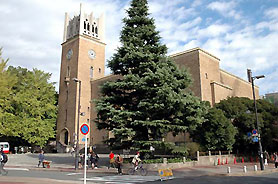
Soon after Ōkuma's death on 10 January 1922, the planning of memorials commenced. The first decision was to construct a large auditorium, something Ōkuma had always dreamed of.
The three-story main auditorium seats 1,435, while the secondary auditorium, located underground, can accommodate 382 people. A seven-story high clock tower stands to the left of the auditorium. The height of the tower, at 125 shaku, or about 38 m, represents the theory of "life of 125 years" advocated by Ōkuma. The bells at the top of the tower were transported through the Panama Canal from the MacLean Company in Baltimore, Maryland. It was the first time that four bells, large and small, had been used in Japan.
Oval-shaped transom windows on the roof represent the sun, moon, and nine planets of our solar system, and symbolize the "harmony of the universe" both inside and outside the auditorium. The auditorium opened on October 20, 1927, about five years behind schedule, after the 1923 Great Kantō earthquake. A Memorial Hall, constructed in 1957, was used as the fencing venue for the 1964 Summer Olympics.[6]
In April 1999, the auditorium along with the old library building were officially designated the first and second historical buildings under the newly-passed Tokyo Metropolitan Landscape Regulations, which aim to preserve buildings representative of Tokyo's history and culture.
The auditorium was designated as one of the important cultural assets of Japan by the Ministry of Education in 2007.
Libraries and museums
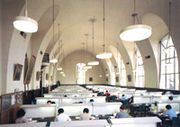
The Waseda University Library, designed by Tachu Naitō, Kenji Imai and Kin'ichi Kiriyama, was completed in 1925. This five-story building, with a total area of 1,195 tsubo (坪) (about 3,944 square meters), was used initially as the University Library. The reading room was housed in a separate two-story building, with a seating capacity of 500. One of the prominent libraries established at the end of the Taishō period, it has been a symbol of Waseda University to this day, along with the Okuma Auditorium and the Theatre Museum.
The Old Library and the administration building were expanded in 1934 and 1955 respectively. The Old Library stopped serving as a main library, after the New Central Library, located where the Abe Stadium used to be, was completed in 1990. It now houses Takata Sanae Memorial Research Library, the University Archives, and Aizu Yaichi Museum. Takata Sanae Memorial Research Library opened in 1994. It is named after former university president Takata Sanae. Historical and cultural materials on Waseda University are exhibited in the University Archives, and the materials related with Ōkuma Shigenobu are exhibited in the Ōkuma Memorial Room at the Archives. Aizu Yaichi Memorial Museum opened in 1998.
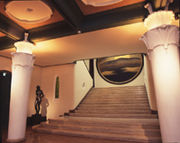
In the front hall, visitors are greeted by the masterpiece "Meian", which dates back to 1927. It is painted on the world's largest hand-made washi (Japanese paper), which is 4.45 meters in diameter and weighs about 12 kilograms. It was manufactured by Iwano Heisaburō, the founder of the Echizen paper works in Imadachi-cho, Fukui prefecture. The masterpiece was painted free of charge by Yokoyama Taikan and Shimomura Kanzan, two artists who represented the modern Japanese style of painting. President Takata Sanae asked them to paint a picture for the Library.
The library possesses a unique collection which survived the Bombing of Tokyo in World War II unlike many of its counterparts. The collection is an important resource for the study of pre-war Japanese history and literature.
Other museums and libraries on Waseda campuses include:
- Waseda University Library
- Waseda University Tsubouchi Memorial Theatre Museum
- Aizu Museum
Athletics
Baseball

The rivalry between Waseda and Keiō University is highlighted by the Sōkeisen in the Tokyo Big6 Baseball League. The baseball series is held twice a year in the spring and autumn at Meiji-Jingu Stadium, and it is considered one of the most important competitions of the year by both student bodies. The Waseda University Baseball Club is the most successful team in the Big6 league in terms of winning percentage, but it has 41 league championships, which puts it second behind Hōsei University.
Football (soccer)
Waseda University football team won the Emperor's Cup, in 1964 and 1967.
Rugby union
Waseda University Rugby Football Club currently is the reigning university rugby union champion in Japan, reaching the university championships 28 times, and winning fourteen times. Its two biggest rivals are Keio University and Meiji University.
- University championship rugby
Karate
The Waseda University karate club is one of the oldest in Japan, formed in 1931 under the direction of Gichin Funakoshi.[7][8] Graduates of the karate club include Shigeru Egami, leader of the Shotokai school, Kazumi Tabata, founder of the North American Karate-do Federation and Tsutomu Ohshima, founder of Shotokan Karate of America.
Notable alumni
Prime Ministers
- Tanzan Ishibashi (1956–1957)
- Noboru Takeshita (1987–1989)
- Toshiki Kaifu (1989–1991)
- Keizō Obuchi (1998–2000)
- Yoshirō Mori (2000–2001)
- Yasuo Fukuda (2007–2008)
Business Leaders
- Takeo Fukui, CEO of Honda
- Norio Sasaki, CEO of Toshiba
- Soichiro Fukutake, president of Benesse
- Masaru Ibuka, co-founder of Sony, recipient of the Order of Culture
- Nobuyuki Idei, ex-CEO of Sony
- Yasujiro Tsutsumi
- Yoshiaki Tsutsumi
- Michael Kogan, founder of Taito Corporation
- Lee Byung-chul*, Founder of Samsung
- Lee Kun-hee, ex-chairman of Samsung
- Kenichi Ohmae, founder and ex-Senior Partner of McKinsey & Co's Japan office
- Isao Okawa, ex-chairman of Sega
- Park Tae-joon, Founder and Chairman of Pohang Iron & Steels Corp, POSCO
- Masamitsu Sakurai, Chairman of Ricoh, Chairman of Japan Association of Corporate Executives
- Mikio Sasaki, chairman of Mitsubishi
- Shin Kyuk-Ho, founder and Chairman of Lotte Group
- Yoshiaki Tsutsumi, founder of Seibu Railway
- Hiroshi Yamauchi, President of Nintendo
- Tadashi Yanai, CEO of Fast Retailing and Uniqlo
- Jose Luis Rodriguez, CEO of Global Comercio, Co. Ltd.
Academics
- Koji Aikyo, law professor at Nagoya University
- Hitoshi Arai, mathematician, professor at University of Tokyo
- Kanichi Asakawa, historian, professor at Yale University
- Shin Chiba, professor of political science at International Christian University
- Kunio Doi, professor of radiology at the University of Chicago [3]
- Hidenori Fujita, educational sociologist, former professor at University of Tokyo, currently professor at International Christian University
- Toshio Fukuda, scholar of robotics, professor at Nagoya University
- Kunio Anzai
- Tatsuo Taniguchi
- Kazuhito Koizumi, (Medical Doctor)
- Hideo Furuido, scholar of theatre arts, professor at University of Tokyo
- Tatsuro Hanada, sociologist of media, professor at University of Tokyo, currently professor at Waseda
- Kazuomi Hirakawa, geographer, professor at Hokkaido University
- Takehiko Kamo (1942–1996), professor of political science at Waseda University and University of Tokyo
- Kang Sang-jung, scholar of history of political thought, professor at University of Tokyo
- Heita Kawakatsu, scholar of economic history, professor at International Research Center for Japanese Studies, President of Shizuoka University of Art and Culture
- Toshihide Kobayashi, Chief Scientist at the RIKEN Advanced Science Institute [4]
- Hideo Kuroda, historian, professor emeritus at University of Tokyo
- Tien-Min Li (Chinese political historian)
- Ichiro Masaki, director of the Intelligent Transportation Research Center, Massachusetts Institute of Technology [5]
- Masako Mitamura, scholar of Japanese literature, The Tale of Genji expert, professor at Ferris University
- Tsunetsugu Muraoka (1884–1946), scholar of history of Japanese philosophy, professor at Tohoku University
- Masahiro Nei, professor of history of economic thought at Kyoto University
- Yoshio Nishi, professor of electrical engineering at Stanford University, the 2002 IEEE Robert N. Noyce Medal recipient [6]
- Toyohiro Nishimoto, archaeologist, professor at National Museum of Japanese History
- Ikujiro Nonaka, scholar of management, Knowledge Management theorist, co-author of The Knowledge-Creating Company, visiting professor at University of California, Berkeley
- Tetsuo Owada, historian, professor at Shizuoka University
- Shojiro Sakaguchi, law scholar, professor at Hitotsubashi University
- Minoru Sekishita, professor of economics at Ritsumeikan University
- Ryūsaku Tsunoda (1877–1964), lecturer of Japanese studies at Columbia University
- Ginzo Uchida (1872–1919), scholar of economic history, professor at Kyoto University
- Ungku Abdul Aziz Ungku Abdul Hamid (Leading Malaysian Academician)
- Saburo Yamada (1869–1965), scholar of private international law, professor at University of Tokyo
- Tokuo Yamamoto, professor of applied marine physics at the Rosenstiel School of Marine and Atmospheric Science, University of Miami; recipient of the 2008 Alan Berman Research Publication Award [7]
- Sakuji Yoshimura (Egyptologist) the president of Cyber University
Authors
- Edogawa Rampo
- Haruki Murakami, novelist, translator, writer, recipient of Franz Kafka Prize
- Ichirō Ōkouchi
- Hakushū Kitahara*
- Kunikida Doppo
- Hiroyuki Yoshino
- Lee Hoesung
- Eto Mori
- Maki Fukazawa (Columnist)
- Rie Yoshiyuki
- Jun Henmi
- Taku Miki, poet, novelist, translator
- Manabu Miyazaki*
- Masuji Ibuse*
- Megumi Mizusawa (manga artist)
- Yoko Ogawa, novelist
- Hisashi Yamanaka
- Miho Toshima
- Hisae Sawaji
- Ototake Hirotada (sports writer)
- Shuji Terayama*
- Taneda Santoka*
- Yoko Tawada
- Tawara Machi
- Yajima Teruo*
- Yokomitsu Riichi*
- Risa Wataya
- Akira Kojima, manga artist
- Masahiko Katsuya, columnist
Journalists
- Soichiro Tawara
- Yoh Henmi
- Satoshi Kamata
Sports
- Norichika Aoki (baseball)
- Kenichi Yazawa (baseball)
- Hiroo Ishii (baseball)
- Kunikazu Ogawa (baseball)
- Akira Ejiri (baseball)
- Soroku Yagisawa (baseball)
- Tamotsu Kimura (baseball)
- Tatsuro Hirooka
- Suishu Tobita
- Toshihisa Nishi
- Motoi Onuki
- Keijiro Matsumoto
- Toru Mori (baseball)
- Shizuka Arakawa (figure skater, 2006 Winter Olympics gold medalist)
- Rena Inoue (pairs figure skater)
- Kunishige Kamamoto (football player)
- Saburo Kawabuchi (football, ex-President of Japan football association and ex-Chairman of Japan professional soccer league)
- Katsuyuki Kiyomiya (rugby player and coach)
- Yukari Nakano (figure skater)
- Hajime Itoi (Olympic swimmer)
- Mikio Oda (athletics, Japan's first Olympic gold medalist)
- Kenji Ogiwara (Nordic combined, 1992/1994 Winter Olympics gold medalist)
- Akinobu Okada (baseball, former manager for the Hanshin Tigers)
- Yoriko Okamoto (taekwondo, 2000 Sydney Olympics bronze medalist)
- Michito Sakaki (Australian rules football)
- Jiro Sato (tennis)
- Takuma Sato* (Formula One driver)
- Hiroaki Shukuzawa (rugby player and coach)
- Fumie Suguri (figure skater)
- Kisshomaru Ueshiba (martial artist)
- Toshihiko Seko (marathon runner)
- Hiroyasu Tanaka (baseball)
- Takashi Toritani (baseball)
- Tsuyoshi Wada (baseball)
- Yoko Zetterlund (volleyball)
- Mitsusuke Harada (martial artist, Head of KDS)
- Shigeru Egami (founder of Shōtōkai karate)
- Tsutomu Ohshima (Chief Instructor of Shotokan Karate of America)
- Ai Fukuhara (table tennis)
- Kenji Tomiki (judo and aikido, founder of Shodokan Aikido)
- Ōnishiki Uichirō (sumo, 26th yokozuna)
- Hironori Ōtsuka* (founder of Wadō-ryū karate)
Performing arts
- Sharon Au (Singapore actress, comedian and television presenter)
- Naohito Fujiki (actor)
- Yasuharu Hasebe (film director)
- Mitsuhiro Hidaka (singer)
- Ryoko Hirosue* (actress)
- Kohei Oguri (film director)
- Shohei Imamura film director, winner of two Palme d'Or awards at the Cannes Film Festival
- Ken Utsui (Actor)
- Bunta Sugawara (Actor)
- Akio Jissoji (film director)
- Haruka Minowa (Comedian)
- Eiichi Otaki (musician)
- Jyongri (singer)
- Go Katou (Actor)
- Kie Nakai (Actress)
- Morio Kazama (Actor)
- Rokusuke Ei (Composer)
- Miho Asahi (Musician)
- Kinya Kitaoji (Actor)
- Seiji Kameda (composer, producer)
- Tamaru Yamada (Musician)
- Hifumi Kato (Shogi player)
- Demon Kogure (singer, sumo commentator)
- Yoshio Kojima (comedian)
- Tetsuya Komuro* (musician)
- Hirokazu Koreeda (film director)
- Tatsumi Kumashiro (film director)
- LaSalle Ishii* (comedian)
- Matsumoto Kōshirō IX (Kabuki actor)
- Keisuke Minami (stage actor, model)
- Tetsuya Murakami (musician, member of The Gospellers)
- Shigeru Muroi* (actress)
- Yuichi Nakamaru (actor, singer (member of KAT-TUN), distantly attending)
- Kazumasa Oda (musician, former member of Off Course)
- Kyosen Ōhashi (TV host and writer)
- Saeko (actress)
- Masato Sakai* (actor)
- Yuji Sakai (musician, member of The Gospellers)
- Sunplaza Nakano* (musician)
- Tamori* (comedian and television presenter)
- Yuya Tegoshi (actor, singer (member of NEWS), distantly attending)
- Kokami Shoji (playwright, director, filmmaker)
- Shinya Ueda (comedian, member of Cream Stew)
- Yutaka Yasuoka (musician, member of The Gospellers)
- Sayuri Yoshinaga (actress)
Diplomats
- Chiune Sugihara*
- Tsuneo Koizumi
- Katsuhiko Oku - rugby player and diplomat, promoted posthumously to ambassador
Politics
- Mikio Aoki*
- Takashi Hiraoka, former mayor of Hiroshima (in office: 1991-1999)
- Iccho Itoh, former mayor of Nagasaki (in office: 1995-2007)
- Fumio Kishida
- Yohei Kono
- Li Dazhao
- Hideo Higashikokubaru, governor of Miyazaki
- Peng Pai
- Soichi Usui
- Hidehiko Noda
- Ichiro Kohno
- Bukichi Miki
- Hirohide Ishida
- Taro Hatoyama
- Kazumasa Okajima
- Fukushiro Nukaga
- Masahide Ota
- Hiroshige Seko
- Mosaburo Suzuki
- Tsutomu Takebe
- Makiko Tanaka
- Kisaburo Tokai
- Kiyomi Tsujimoto
- Kozo Watanabe
- Yoshimi Watanabe
- Yuji Yamamoto
- Taku Yamasaki
Others
- Eiko Onuki
- Nancy Andrew (translator, junior year, 1967–1968)
- Yuji Horii (video game designer)
- Yoshio Shirai
- Masato Koizumi (Minister)
- Tensai Okamura (director)
- Thomas P. Logan (businessman-venture capitalist, 1982–84)
- Tomonobu Itagaki (video game designer, School of Law, 1985–92)
- Shizuo Tsuji
- Masuhiro Yamamoto
Notable current students
Sports
- Yuki Saitō (baseball)
- Masumi Kuwata (baseball)
Performing Arts
- Natsuki Satō (member of idol group, AKB48)
- Jyongri (singer)
Notable faculty
Professors who are also Waseda alumni are listed in italics.
- Yaichi Aizu, poet, scholar of ancient Chinese and Japanese art, and namesake of Aizu Museum
- Tameyuki Amano, economics scholar and educator
- Yasunobu Fujiwara, scholar of political science
- Lafcadio Hearn, novelist, literary scholar, professor of English literature
- Smimasa Idditti (Sumimasa Idichi ), professor of English
- Kenji Imai, architect
- Tokio Kimura, historian
- Kunitake Kume, historian
- Tachu Naito, architect
- Naoyoshi Nakamura, historian
- Haruo Nishihara, law professor, former President
- Takayasu Okushima, law professor, former President
- Hajime Ōnishi, philosopher
- Ikuo Ōyama, scholar of political science
- Yaso Saijo, poet
- Masasada Shiozawa, scholar of economics, former President
- Sanae Takata, scholar of political science, former President
- Ōdō Tanaka, philosopher
- Shoyo Tsubouchi, playwright, critic, translator, educator, professor of English literature, and namesake of Tsubouchi Memorial Theater Museum
- Sokichi Tsuda, historian, recipient of the Order of Culture
- Kazutami Ukita, scholar of political science
- Yoshio Yamanouchi, translator, scholar of French literature
- Akira Yonekura, law professor
- Takamasa Yoshizaka, architect
Principals, de facto presidents (1907–1923), and presidents
Principals
- Hidemaro Ōkuma, 1882–1886
- Hisoka Maejima, 1886–1890
- Kazuo Hatoyama, 1890–1907
De facto presidents (1907–1923)
- Sanae Takata, 1907–1915
- Tameyuki Amano, 1915–1917
- Yoshiro Hiranuma, 1918–1921
- Masasada Shiozawa, 1921–1923
Presidents
- Shigenobu Ōkuma [9], 1907–1922
- Masasada Shiozawa, 1923
- Sanae Takata, 1923–1931
- Hodumi Tanaka, 1931–1944
- Tomio Nakano, 1944–1946
- Koichi Shimada, 1946–1954
- Nobumoto Ōhama, 1954–1966
- Kenichi Abe, 1966–1968
- Tsunesaburo Tokikoyama, 1968–1970
- Sukenaga Murai, 1970–1978
- Tsukasa Shimizu, 1978–1982
- Haruo Nishihara, 1982–1990
- Chūmaru Koyama, 1990–1994
- Takayasu Okushima, 1994–2002
- Katsuhiko Shirai, 2002–present
Trustees
- Ryuhoku Narushima, poet, journalist, and one of the first trustees of Waseda
- Azusa Ono (1852–1886), law scholar and one of the first trustees of Waseda
Benefactors
Waseda University has had numerous benefactors, including:
- Eiichi Shibusawa [10], businessman and philanthropist
- Ichizaemon Morimura [11], businessman
- Koichiro Kagami [12], businessman
- Kenkichi Kodera [13], presenter of over thirty-six thousand foreign books to the Library
- Kisaku Maekawa [14], businessman and philanthropist
- Masaru Ibuka, after whom Masaru Ibuka Auditorium (Hall) [15] is named.
- Robert J. Shillman, founder & CEO of Cognex Corporation, namesake of Robert Shillman Hall
Waseda University in media
Nonfiction
- ULTIMATE CRUSH: Waseda University Rugby, Leadership and Building the Strongest Winning Team in Japan by Katsuyuki Kiyomiya, translated into English by Ian Ruxton (September 2006). ISBN 978-1-4303-0321-3 . The original was a book by Mr. Kiyomiya published in Japanese in February 2006 entitled Kyukyoku no Shori:Ultimate Crush ISBN 4-06-213271-0 .
- Manabu Miyazaki; Toppamono: Outlaw. Radical. Suspect. My Life in Japan's Underworld (2005, Kotan Publishing, ISBN 0-9701716-2-5)
Fiction
- In the novel Norwegian Wood, written by Haruki Murakami, the main character goes to a university modeled after Waseda.
- In the manga series Great Teacher Onizuka by Tooru Fujisawa, the heroine Azusa Fuyutsuki is a graduate of Waseda University.
- In the video game Tomb Raider: Legend, a piece of the legendary sword Excaliber is in the care of Waseda University until it is stolen.
Scandals
Super Free was a registered Waseda University school club organized by Shinichirō Wada, a student at Waseda University. The club would organized parties in order to rape unsuspecting women. The appeal of the these parties was the chance to associate with Waseda University students. After Wada's arrest, the club was disbanded.[16]
See also
- List of National Treasures of Japan (writings)
Notes
- ↑ Kimura, pp. 74, 123
- ↑ Kimura, pp. 74, 122
- ↑ Okushima and Nakamura (eds.), p.42
- ↑ Okushima and Nakamura (eds.), p.25
- ↑ Okushima and Nakamura (eds.), p.37
- ↑ 1964 Summer Olympics official report. Volume 1. Part 1. pp. 127-8.
- ↑ Funakoshi, Gichin (1973). "Karate-do Kyohan", Kodansha International Ltd, Tokyo. ISBN 0-87011-190-6.
- ↑ "A Karate Club with a long history". Waseda Weekly. 2006-11-16 accessdate = 2008-12-22. http://www.waseda.jp/student/weekly/contents/english/e110b.html.
- ↑ as an honorary post
- ↑ Okushima and Nakamura (eds.), p.53
- ↑ Okushima and Nakamura (eds.), p.51
- ↑ Okushima and Nakamura (eds.), p.63
- ↑ Okushima and Nakamura (eds.), p.65
- ↑ Okushima and Nakamura (eds.), p.68
- ↑ Masaru Ibuka Auditorium (Hall) is in the International Conference Center.
- ↑ "Revealed: the workings of a uni rape club". The Age. 2003-07-05. http://www.theage.com.au/cgi-bin/common/popupPrintArticle.pl?path=/articles/2003/07/04/1057179156476.html. Retrieved 2008-10-28.
References
- (Japanese) Kimura, Tokio. Waga Waseda: Ōkuma Shigenobu to sono kengaku seishin, Tokyo, Kobunsha, 1997.
- (Japanese) Okushima, Takayasu.; and Nakamura, Naoyoshi., eds. Tōmonno gunzo, Tokyo, Waseda University Press, 1992.
External links
|
|||||||||||||||||
|
||||||||||||||||||||||||||||||||||||||||||||||||||
|
|||||
|
|||||